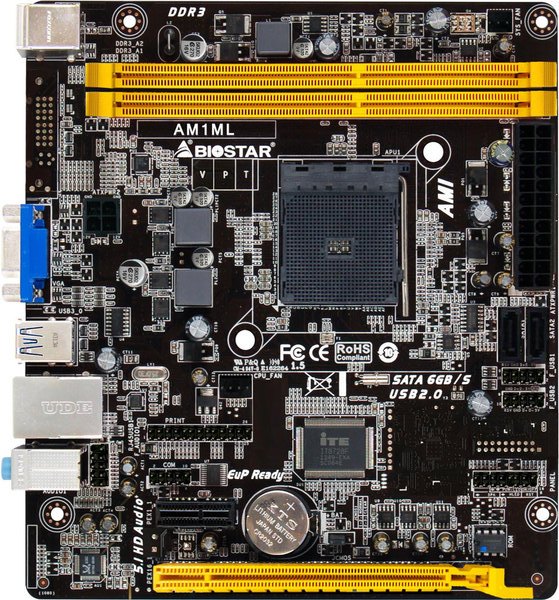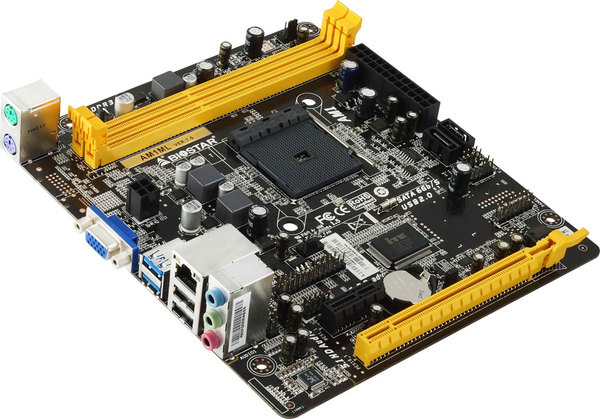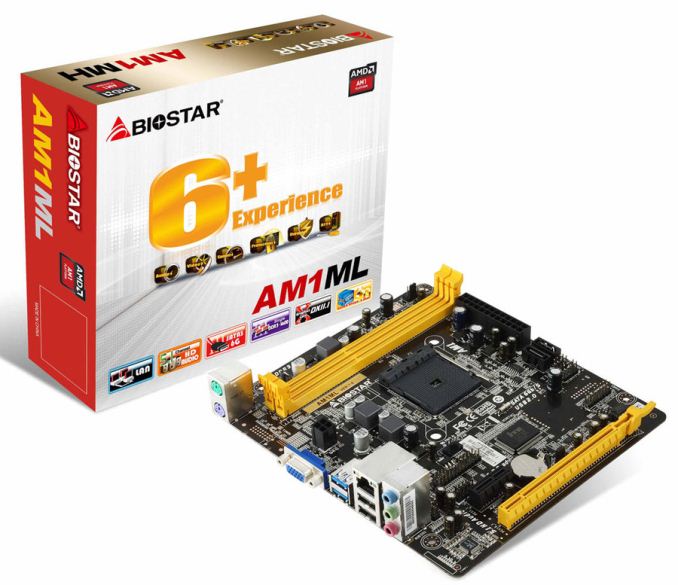The AM1 Kabini Motherboard Preview: Analyzing the Hardware
by Ian Cutress on April 19, 2014 2:00 PM ESTBiostar AM1ML
Every so often at AnandTech we review a Biostar motherboard, and sometimes we get some exciting features (the first manufacturer to test fan profiles in the BIOS) but they mostly end up as a budget play in a market with plenty of players. As part of the AM1 release Biostar hase two motherboards on sale, the cheapest of which is this AM1ML coming in at $33.
Straight off the bat the AM1ML does a couple of things differently compared to a regular motherboard:
First thing I noticed was the arrangement of the DRAM slots. Horizontal placement on a small form factor motherboard has been attempted by ASRock in the past on their channel range, but this type of arrangement is usually restricted to server type builds.
Second was the motherboard size. In my mind I immediately said mini-ITX, however on closer inspection this motherboard is essentially a mini-ITX ‘plus’. It contains the standard 17cm x 17cm layout of a mini-ITX, plus a couple more at the bottom, but not enough for a microATX. This means that this motherboard will not fit in mini-ITX cases unless the case has room for a dual-slot GPU. As a result of this configuration, we get a PCIe 2.0 x1 slot alongside the full-sized x4 slot.
As with many small form factor boards, my ire is often pointed at the location of the CPU power connector. Biostar has it placed near the rear IO of the motherboard, causing cables to be stretched over the motherboard (or DRAM, CPU or GPU). This is ultimately bad planning by an engineer who has a different idea about small form-factor systems than I do. As this is the cheapest AM1 motherboard on Newegg today, there is no surprise that we get the bare minimum. Two SATA 6 Gbps ports, two USB 3.0 ports, and there is even room for a printer port and a COM port.
The back panel is essentially bare, with support for separate PS/2 peripherals and a single VGA port for video output.
Perhaps a surprising kicker is the Ethernet port. Biostar are using a Realtek RTL8106E, which as codenames go is pretty generic, but this is a 10/100 Ethernet port. I never thought I would ever see a socketed motherboard in 2014 ship with a less-than-gigabit Ethernet port. My mind is blown.
The audio is subsequently bottom of the barrel as well – the ALC662 is commonly used on low cost platforms and laptops.
| Biostar AM1ML | |
| Price | Link |
| Size | Mini-ITX Plus |
| CPU Interface | FS1b |
| Chipset | AMD Kabini |
| Memory Slots |
Two DDR3 DRAM Slots Supporting 16GB Single Channel, Up To 1600 MHz |
| Video Outputs | VGA |
| Onboard LAN | Realtek RTL8106E - 10/100 |
| Onboard Audio | Realtek ALC662 |
| Expansion Slots |
1 x PCIe 2.0 x16 (at x4) 1 x PCIe 2.0 x1 |
| Onboard SATA/RAID | 2 x SATA 6 Gbps |
| USB 3.0 | 2 x USB 3.0 (Chipset) [back panel] |
| Onboard |
1 x LPT Header 2 x USB 2.0 Headers 2 x SATA 6 Gbps ports 1 x Front Audio Header 1 x Front Panel Header 2 x Fan Headers 1 x COM Header |
| Power Connectors |
1 x 24-pin ATX 1 x 4-pin CPU |
| Fan Headers |
1 x CPU (4-pin) 1 x SYS (3-pin) |
| IO Panel |
PS/2 Mouse Port PS/2 Keyboard Port VGA 2 x USB 3.0 2 x USB 2.0 1 x NIC (10/100) 3 x Audio Jacks |
| Product Page | Link |
For $33, the Biostar AM1ML gave me a few surprises on the hardware side of the equation. I do not imagine we will have time for a full review to test performance or software, but cheap is cheap.














64 Comments
View All Comments
JFish222 - Monday, April 21, 2014 - link
I agree, its disappointing that there is no ECC. (At least not listed.)I was really looking forward to using one of these for a low cost FreeNAS box.
Ian, Anand and company. Please encourage ECC bios support/validation! If any of the manufacturers support it (not always obvious when they do) please point it out.
For those that don't understand the importance, ZFS has numerous benefits but its greatest weakness is the ability to corrupt the entire data pool due to a flipped bit or 2 in RAM.
For more info - http://forums.freenas.org/index.php?threads/ecc-vs...
Chicken76 - Monday, April 21, 2014 - link
Indeed, Anandtech has the ear of motherboard manufacturers. They might respond positively if such suggestions are properly argumented. There's not only the enthusiast home user that these might be useful to, there's also the small businesses sector, where cost is a deciding factor. Add ECC support and a bit of validation for production use, and a lot of the cost-conscientious businesses will refresh their storage boxes and low workload machines using Kabini, instead of the Pentiums and Celerons they use now.rogueninja - Sunday, April 20, 2014 - link
Only bad friends recommend AMD.meacupla - Sunday, April 20, 2014 - link
Currently, AMD's most attractive CPU parts are the $60 A6-6400k and $120 FX-6300.Pentium and i3 have more single thread computing power, but looking at the entire package, AMD has some advantages at those price points.
Like a cheap 8 port SATA mobo, you can't have that with cheap LGA1150 boards.
or having 6 physical cores.
Antronman - Monday, April 21, 2014 - link
Except that when you're on a low budget, AMD is the only thing you should be recommending.Ortanon - Tuesday, April 22, 2014 - link
Intel usually wins low-budget too, haha. If you're talking "best gaming performance at the absolute bottom," yes, AMD wins. But who wants to game down there? As soon as you try to add any performance to your build whatsoever, it turns into an Intel solution with a PCIe GPU. It's possible that this would be different if all software was highly-threaded, but it just doesn't work out that way.AlB80 - Sunday, April 20, 2014 - link
Gigabyte's mobo has heatsink. What behind it? SuperIO?DuckieHo - Monday, April 21, 2014 - link
Biostar's mITX-Plus..... isn't that just AMD's DTX form factor?JBVertexx - Monday, April 21, 2014 - link
Stumbled across this - PC build in the motherboard box:https://www.youtube.com/watch?v=xngzjrKg3zI
WeatherDave - Monday, April 21, 2014 - link
"COM port, LPT port and a TPM port on the same PCB"We have about 50 machines here. Mostly for embedded testing, such as stepper motors, and old equipment that ONLY connects via Serial Port. USB converters are both unreliable and prone to failure, so we like having the COM ports on board. Besides, Windows 98/2000 and XP much prefer them over a converter. Now, we don't have much use for the LPT, but TPM and a cheap SSD certainly keeps IT Security off our backs.